From the history of "weapons of retribution"
On the night of June 13 1944, the plane, which cracked like a motorcycle, swooped down within the precincts of the British capital and exploded. A survey of the terrain revealed one feature: there was no pilot in the aircraft. So the British discovered a new German means of air attack - cruise missile V-1. In those years, such devices preferred to be called "projectile aircraft."
The first projects of long-range guided missiles, equipped with wings, were proposed as early as the First World War. In the interwar period, development work on cruise missiles with rocket engine were conducted in many countries, including the Soviet Union and Germany. The fact that the Third Reich was the first to apply the new weapon, is fully explained by the funds that were invested in the project, as well as the traditionally high level of development of German industry.
The leadership of the German Air Force became interested in missile aircraft in 1939. The initiation of their development became a kind of response from the department of G. Göring to the “army” project of the A-4 ballistic missile, which later became widely known as V-2. In the middle of the summer, the Argus and Fizeleler 1941 companies proposed a cruise missile with an estimated range of 250 km, which was based on the ideas of F. Gosslau unmanned aircraft and P. Schmidt’s extremely simple pulsating jet engine. cheap fuel. The occupation of northern France made it possible to bombard London and many other cities in England with similar shells.
In January 1942, a project called for secrecy purposes FZG-76 (a flying target for training combat defense missile defense) was presented to the leadership of the Ministry aviation, and in July they reported about him to the chief of the technical service of the Luftwaffe, Field Marshal Milch. Simplicity and low cost provided the project with the status of "top priority". It was decided to take the "target" into service no later than December 1943.
Already in April, 1942 had outlined plans for the development of a cruise missile to Robert Lusser, who was engaged in various tasks on self-propelled bombs at the Fizeler factory in Kassel. Knowing this, the project coordinator, staff engineer, Bree, from the Ministry of Aviation, approved the Fizeler company as the main developer. The supplier of the control system chose the company "Ascania". Lusser was attracted to the work of the teams of the DFS, Henschel and Schwartz enterprises, who in the 1930-1937 worked in related fields.
This made it possible for the 1942 in December to test a prototype in a planning flight after being dropped from an FW-200 Condor aircraft. And in just a few days, the prototype FZG-76 made its first flight at a distance of 2,7 km with the engine running. After the 50 launches, the main characteristics of the cruise missile were determined: range - 240 km, speed - 550-600 km / h, flight height - 200 - 2000 m, weight of the combat charge - 700 kg. At the same time, the capabilities of the missile were tested to overcome the British air defense. They made several training interceptions of the new aircraft by the captured fighter "Spitfire" Mk.V. This, by the way, led to an underestimation of the enemy forces, since the speed of subsequent modifications of the English interceptors Spitfire and Tempest were much higher.
In May, 1943, an authoritative commission at the Peenemünde training ground, heard the comparative characteristics of the FZG-76 and the V-2 (V-2) ballistic missile. A show and practical shooting took place. The launch of the two V-2 was quite successful, and both FZG-76 launches ended in an explosion a few seconds after the start. However, the missile launches looked so impressive that even these accidents did not shake the German leadership’s confidence in the new weapon. The commission decided to speed up the serial production as much as possible and recommended using both types of missiles in the complex. The cruise missile was given the name Fi-103, but it became better known under the unofficial name V-1. “V” (German “fau”) meant Vergeltungswaffe, “a weapon of retribution”. The Goebbel apparatus declared that it was intended for "retaliation" for the barbaric destruction of the American-British aviation of Lübeck and Hamburg.
A program was developed for the production of projectiles from August 1943 of the year to July 1944-th, providing for the release of 24,5 thousand. V-1, bringing the 1944-th monthly assembly to May 5000 pieces. But the Ministry of Weapons was unable to ensure such a pace of work. Indeed, only for the monthly production of 3 thousand V-1 chemical industry required 2 thousand tons of low-octane gasoline and 4,5 thousand tons of explosives. Not better deal with other required materials and semi-finished products. In addition, only in September 1943 was made more 150 additions and changes to the project.
Despite this, in the spring of 1943, the accelerated formation of missile units began. At the Zintovititz test site (Usedom Island), an 155 anti-aircraft regiment was formed under the command of Colonel M. Wachtel. The name "anti-aircraft" and the encrypted names of the commander "Michael Wagner" and "Martin Wolf" were given for conspiracy considerations. The regiment consisted of four divisions, which included four fire and two auxiliary batteries (maintenance and supply).
From October 1939, British intelligence began to receive data on German developments in the field of rocket weapons. The information was stingy and scattered, but it led to the conclusion that work on ballistic and cruise missiles of immense destructive power was literally in full swing in Germany. Tests are conducted at a mysterious test site somewhere in the North Sea, launch positions are being prepared on the coast of the English Channel, and mass production is already under way at the plants.
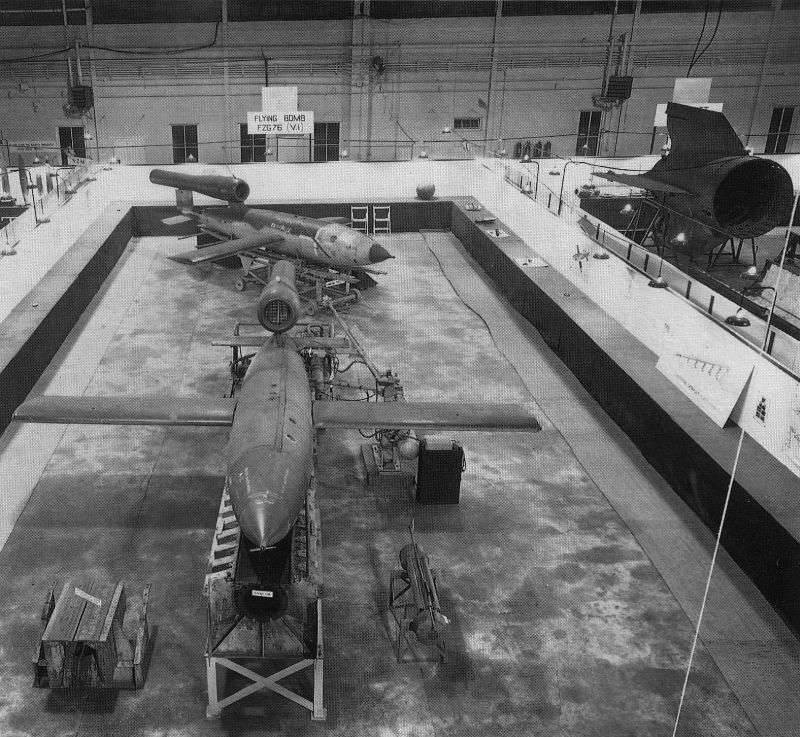
The flow of information gradually increased. This was reported by the resistance groups from Poland and France, the captive generals Griuvel and Tom, the anti-fascist engineer Hans Kummerov, who worked at the Berlin Higher Technical School. 15 May The 1942 th photo reconnaissance Spitfire took the first shot of the landfill and airfield at Peenemünde. Since then, the island of Usedom has not gone out of the scrutiny of British intelligence.
The hard work of the scouts embodied the 17 of August 1943, in Operation Hydra - a strike on Peenemünde. In order to disorient the Luftwaffe, eight Mosquitoes, dropping aluminum foil over the ground, which was “blinded” by air defense radars, rushed at Berlin. Following them, 597 heavy bomber flew up only to the "mysterious island". Finding a huge cluster of aircraft over the Baltic, and following the path of the eight Mosquitoes, the Germans decided that a massive raid was expected on the capital.
When the Moskito reached Berlin and dropped the lighting and marking bombs, the German command ordered the night fighters to be raised into the air and the 160 daytime fighters additionally attracted. In the confusion, they attacked their own night interceptors, then joined the anti-aircraft artillery. For two hours, an “air battle” took place over Berlin without the participation of enemy aircraft. Meanwhile, almost 55 and high explosive or more 1600 and incendiary bombs fell on Peenemünde. As a result of the raid, 280 people died. 732 from the 50 landfill buildings and 80 from 18 barracks for workers, the power plant and the plant that produced 39-20 liquid oxygen were destroyed. The British lost their 40 aircraft.
Meanwhile, aerial photography of the English Channel brought more and more interesting information. In two days, from 8 to 10 in November, the number of starting positions increased from 19 to 26, and after two weeks there were already 95. Comparing several shots of the Peenemünde test site, one of the cryptographers found the same positions, but equipped with rail guides. They had a small airplane without a cabin with a straight short wing, which in English intelligence was given the name Peenemünde-20.
Almost a year before the start of the rocket attack, it became clear that of the two types of new weapons - ballistic missiles and "flying bombs" - the latter would be the most dangerous. Captured German pilots from the KG-100 squadron, which was armed with non-111 bombers, told that they experimented with the launches of winged shells. And in the report received by the head of the department of scientific and technical intelligence of the Ministry of Aviation, it was noted that this type of weapon would be used first.
The British command decided to thwart the enemy’s plans with the help of the bombing of enterprises that manufacture unmanned aircraft and launchers. From 5 December 1943, American and British aircraft began bombing launch sites and VW-1 rocket warehouses. Within six months, 52 was completely destroyed from 36 launch pads, and 96 was destroyed from 88 projectiles warehouses. In total, Allied bombers carried out more than 25 thousand sorties to rocket targets located near the coast.
But after that, the British could not breathe easy, as the German game of "cat and mouse" made them throw bombs into the sand. The Germans directed all their efforts to the construction of small concrete platforms. By June 1944, intelligence had already discovered 69 of such objects. The analytical departments of British intelligence did not even suspect that the installation of the 6-meter section of the assembly structure with guide rails required only 48 watches.
In December 1943, the British Air Defense Command received an order to develop a protection plan against the V-1. It was necessary to reorganize the existing air defense system, which during the “Battle of Britain” covered London and the industrial cities of central England. The situation was quite difficult: after all, only Tempes and Spitfires XIV could successfully fight V-1. And then they removed all the excess equipment from them, washed off the protective paint and polished the lining to shine. Only in this situation, with an increase in speed on 35 — 50 km / h, did they become a truly formidable opponent for cruise missiles.
6 June 1944-th (a few hours after the landing of the allied troops in northern France), the radio operator of the 155-th "anti-aircraft" regiment of airplanes received a coded cipher. The headquarters of the 65 Army Corps ordered Colonel Wakhtel to bring his regiment to alert on 12 June. June 10 through Ghent to the advanced warehouses was followed by the first 90 train with Fau-1 shells. Wakhtel intended to postpone missile launches to 20 numbers. He reported that he lacked fuel and many supplies, and prefabricated launchers were not fully prepared. But the command did not pay any attention to the report and issued an order for strikes on London on the night of June 13.
During the period of the systematic bombardment of London, from 13 June to 5 September, 9017 rockets were fired at the British capital, but some launches were unsuccessful. About 2 thousand V-1 exploded shortly after the start or on the flight path to the target. In the beginning, the effectiveness of the application was very high. 82% V-1 exploded within London during the first week of launches, but by the end of the month this number had dropped to 60%.

To make it difficult to fight a new weapon, the Germans alternated massive salvos from all installations and single disturbing launches in the course of one “launching” day. Few people know, but the flight altitude of cruise missiles, equal to 900-1000 m, was not chosen by chance. The missiles went below the line of defeat by heavy artillery and above the effective fire zone of small caliber artillery. At this altitude, a small-sized cruise missile was poorly detected by radars and was a difficult target for automatic and manual anti-aircraft defense and fire control devices.
Fighter pilots also required great skill and considerable courage to, often in bad weather conditions, to destroy a small-sized target. It had to be hit from behind-to-top from a distance of more than 100 m, since the 800 kg of explosives undermined the deadly threat to the attacking aircraft.
All this gave rise to unusual ways of dealing with projectiles. One of the French officers in the royal air force, captain Jean-Marie Maridor, closely led his Tempest to a flying rocket and knocked it over with a wing console. Other pilots adopted the tactics of Maridor, and the courageous 24-summer pilot, General Charles de Gaulle, presented the Order of the Legion of Honor. The brave pilot was killed 4 August 1944 g., Rammed a hollow dive-dive V-1.
A different method of destroying the V-1 without the use of small arms was also used: some Tempest pilots made the cruise missile roll over and crash into the ground with the help of its fighter jet propellers. Although these methods brought victory in the fight against "flying bombs", most of the pilots managed with standard weapons, while achieving significant success. One of the most successful was the squadron commander T. Barry, on his account were 37 destroyed cruise missiles.
V-1 prefabricated launchers were easily restored after Allied bombers raids. Therefore, despite the efforts of the Allies, in June-July of the 1944, the intensity of the V-1 raids did not noticeably decrease. On some days, the British Air Force patrolled up to 160 cruise missiles.
In order to somehow solve this problem, the Americans developed a rather extravagant Anvil plan, according to which B-17 aircraft, which served their time, served as precision weapons. In the “flying fortresses”, the upper part of the cabin was cut to facilitate the escape of the plane by two crew members, to install television equipment and a radio command and control system. After the B-17 loaded with explosives took off, the crew took the plane to the course and left the parachute bomber. Further control of the B-17 was carried out with a fighter that flew a parallel course. From the height of the 6000, the fighter pilot detected and recognized the target, after which the radio-controlled bomber was diverted into a dive. The 4 and 6 of August were thus destroyed targets, securely protected by solid reinforced concrete shelters, in the areas of Spracot, Watton and Virzen.
From the second half of July, the bombing of the supply bases and factories related to the production of missiles was resumed. In less than a month, 20 made large allied strategic aviation raids into V-1 warehouses. 15000 airplanes were committed to objects of the rocket industry and 48 000 tons of bombs were dropped.
New 6-ton bombs “Tollboy” were used against the underground missile warehouse in Saint-Ezerne, the Volkswagen plant in Fallerslebene, the pilot plant in Peenemünde and the Opel plant in Rüsselheim. However, strikes against industrial facilities in Germany could not have had any serious impact on the production of cruise missiles. The pace of production has even increased. Primarily due to the fact that since July 1944, the assembly of the Fow-1 has concentrated in Nordhausen, on an underground plant invulnerable to air raids.
The missile defense system of England consisted of four zones: the outer and inner zones covered by fighters, the coastal anti-aircraft artillery zone and the barrage balloon zone. The outer zone included the airspace over the English Channel to the coast of Britain. Four to six Mustang Mk.III fighters and a Spitfire Mk.KhIV patrolled there during the day, or the 3-4 of the aircraft at night. The 15 spacecraft of the radar patrol, which were aimed at interceptors, were also located here. Their light anti-aircraft guns also fired on flying cruise missiles.
During the summer of 1944, the loss of the English population from missiles amounted to about 21400 people killed and wounded. 25511 houses were completely destroyed, and a huge number of buildings received damage of varying degrees. Only in densely populated areas of London and its suburbs suffered up to 75% of buildings. This is all that the creators of the “miracle weapon” could “be proud of”.
Left without a starting position system as a result of the Allied summer offensive, the Germans refused to launch the V-1 in England from the territory of France and redeployed the 155 th anti-aircraft missile regiment from Holland to Germany. The new targets were the cities of Antwerp, Brussels and Liege. The combat experience of launching the V-1 from carrier aircraft, first conducted on July 8, allowed strikes against Britain from various directions, bypassing the already established air defense system. About one hundred aircraft carriers from three air groups were used.
Until 14 in January, X-NUMX F-1945 was launched around the cities of England with bombers. For the crews of carrier aircraft, this was not an easy task. Night flight without landmarks over the sea at an altitude of 1200-1 m, reaching the launch line at a distance of 100-300 km from the coastline, gaining a height of several thousand meters, maintaining an accurate course during V-50 dumping presented considerable difficulties. At the same time, it is necessary to remain invisible to radar stations and night interceptors. Here you should add the threat that your own projectile represented for the crew: from 60 crews of Non-1, who did not return to their airfields, 77 died at the moments of launch of rockets.
Although Heinkels made rocket terror more mobile, they acted sporadically, and the scale of their use was relatively small. The British still managed to shoot down about half of the projectiles.
However, in February 1945, the German designers created an improved version of the V-1, with the launch range increased to 370 km. On the territory of Western Europe they managed to build three ground launch positions aimed at London. After it became known to British intelligence, two of them were destroyed. From the third launcher, located near the city of Delft, starts were made throughout March.
In February, 1945, Hitler said that the secret "miracle weapon" at the last moment will change the situation in favor of the Third Reich. This was said just two months before the fall of Berlin. The bet on rocket weapons clearly failed, but again and again there were orders to increase the production of V-1, which was reduced to 2000 copies per month. New aircraft carriers were supposed to be jet bomber "Arado" Ag-234-2. The towing and launching of the V-1 with the help of a rigid coupling was envisaged.
In the alternative, the projectile should have been mounted on a launch ramp above the rocket carrier’s fuselage. Rocket specialists, technical documentation, unique prototypes and the latest equipment were evacuated to Nordhausen, where the production of rockets continued with all their might. The last projectile fell on the territory of England 29 March 1945 th.
The Soviet military command also took into account the possibility of the use of Fau-1 by the fascists on the Eastern Front. With the beginning of the first combat launches in England, the General Headquarters ordered the artillery commander N. Voronov to take all measures to protect Leningrad and other large cities from unmanned vehicles. 19 July 1944-go were approved and sent to the Air Defense Forces "Advance directives to combat aircraft-shells". According to a specially developed plan with the allocation of the necessary forces and means in the area of responsibility of the Leningrad air defense army, two sectors were created: the north-west and the south-west. But the rapid retreat on the Eastern Front, as well as the desire of the Nazi elite, at least for the last time to punish the “foggy Albion” did not make it possible to apply the V-1 against the Soviet Union.
A large spread (up to 80% of shells fell at a distance of more than 6,5 km from the target point) and the impossibility of aimed fire due to the lack of range correction and lateral demolition led the Luftwaffe to create a manned version based on V-1.
Obertshurtmbannführer SS Otto Skorzeny, a well-known saboteur, terrorist, developer and performer of various covert operations, and the best German pilot Hanna Reich became the inspirers of the project. The chief of staff of the Luftwaffe, Günter Korten, ordered the commander of the special purpose squadron KG 200, Colonel V. Baumbakh, to form a separate combat training group. Thus, inside the KG 200, a squadron of "Leonidasstaffel" was formed, which included 60 experienced pilots and test pilots of the Rechlin research center.
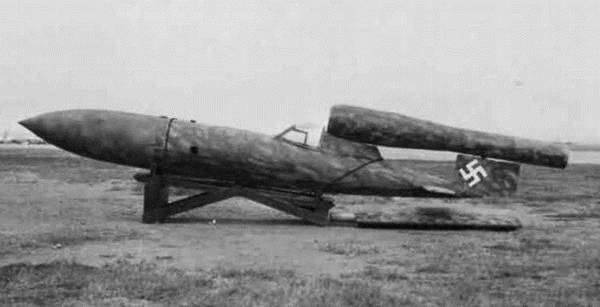
The plant in Danneburg redid the 175 V-1 into manned projectiles. They were removed from the system of automatic stabilization, and in place of the cylinders with compressed air equipped cockpit with controls and a minimum number of instruments, the wing was equipped with ailerons. Single and double training versions of the manned Fi-103 aircraft with a landing ski were made, and for the combat version no chassis was envisaged at all.
At the same time, several instances of four manned projectiles under the name "Reichenberg" were being built. These are the “Reichenberg I” - a double, training one, with an increased wing span, without a pulsating air-jet engine (PUVD), the “Reichenberg II” is a single-seat training one, with a PU-ATD, “Reichenberg III” with a combat weight model parts and landing skis, "Reichenberg IV" - with a warhead, PUVD, without a landing skis.
The very first test of a manned projectile "Reichenberg III", which Skorzeny and Reich observed from the ground, ended in disaster. After undocking from the aircraft carrier, the aircraft for some time maintained a given direction and height, and then suddenly went down, disappeared behind the forest and exploded. Hanna Reich, who had experience flying Me-163, carried out further tests herself.
During the research flights it turned out that the “Reichenberg” has unsatisfactory flight data. Moreover, he was particularly dangerous at landing with the released ski, which was noted by other test pilots. To carry out the previously planned departure of a manned projectile with a parachute was not possible, since the engine air intake gaped directly behind the lamp. A catapult was required.
The failing test results of Reichenberg did not stop the top of the Nazi leadership. To improve the flight performance, Porsche was given a technical assignment for the development of a disposable turbojet engine "109-005" with a power 5000 hp. Combat samples of the Reichenberg IV manned projectile began to descend from the building stocks, of which even entered the training unit. But it never came to their combat use.
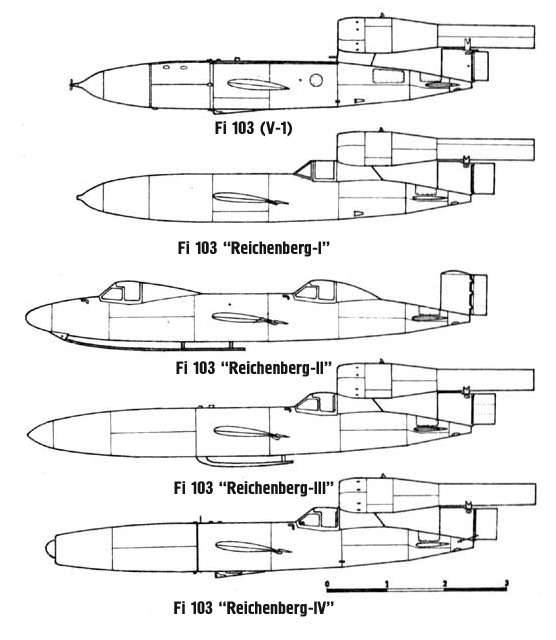
During the war years, the German industry manufactured more than 20440 cruise missiles (of the planned 60000). From July 1944 th to March 1945 th only X-NUMX V-10492 was released to England. Of these, 1 hit London, 2419 "flying bombs" fell to other cities. 1112 is launched on Antwerp and 8696 on Liege. Although out of this number 3141 was hit by interceptors, 1847 - anti-aircraft artillery, 1878 pieces got into the barrage balloon cables, and 232 just didn’t fly because of low technical reliability, it became clear to the military and politicians that a new means of warfare had appeared with huge potential .
Summing up the combat use of the world's first serial V-1 cruise missiles, it can be argued that they could not meet neither the military nor the political expectations of the leadership of the Third Reich. Despite the really strong moral impact made on the population of Great Britain, especially in the first period of applying V-1, the British determination to wage war to a victorious end was not shaken.
But story V-1 did not end with the capitulation of Germany. Ballistic and cruise missiles captured at the end of the war, several tons of technical documentation, launch equipment, production technology, captured specialists and the experience gained by them — that was the most valuable trophy of the winners.
Many countries began to urgently test, modify and quickly put on armament of their armies the latest German developments in various areas of military equipment. The United States was the first to embark on this arms race. Already 9 June 1944, the fragments of unexploded V-1 were delivered by plane to the Reitfield airbase. The group of aircraft designers urgently reconstructed the components and assemblies of the cruise missile, and only seventeen days later the first real model of the projectile was ready. Serial production of rockets under the designation B-2 was assigned to the company “Republic”, and the production of a pulsating engine - the company “Ford”. Until the end of the war, the Americans made about 1200 rockets, called KUW-1 "Lun", but did not have time to use them. The development of the V-1 was the SSM-N-8 “Regulus I”, launched by the Americans in the early fifties into mass production to equip heavy cruisers and large special submarines.
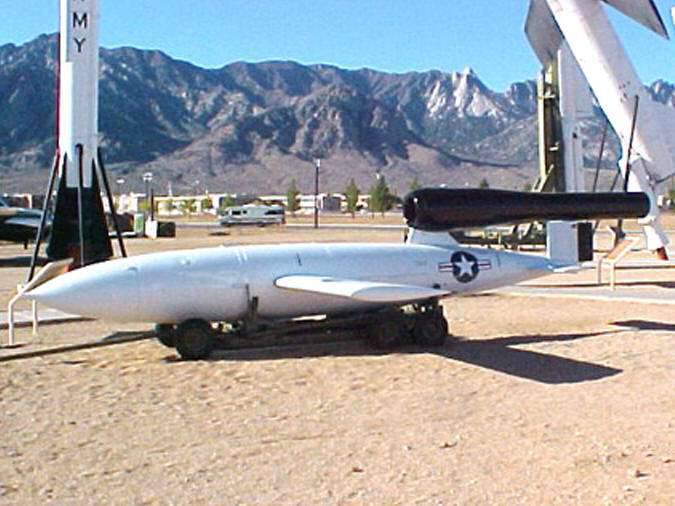
The Soviet Union did not stay aside. Despite the fact that our military experts had a very low opinion of the combat capabilities of the Fau-1 projectile, by the end of 1944, the aircraft factory No. 51 began building an analogue of the German rocket based on the Fau-1 sample received from Britain and individual parts and components found on the territory of Poland. The tests of the projectile, called "10X", conducted in August 1945 year. Further consistent development of the 10X cruise missile proceeded under the direction of V.N. Chelomey.
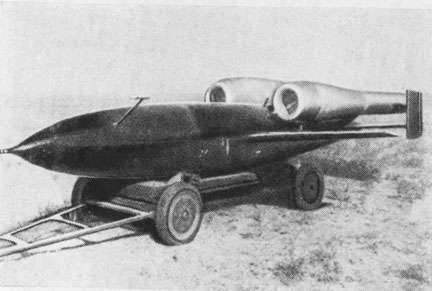
The modifications 10XH and 16X were created, which differed from the German projectiles in high operational reliability. But at the end of 1952, it was decided to stop work on the creation of cruise missiles based on the V-1.
Sources:
Orlov A. The Secret Weapon of the Third Reich. M .: Science, 1975. C.71-76.
Khvoschin V. Projectile V-1 // Wings of the Motherland. 1995. No.5. C. 20-23.
Kozyrev V. Kozyrev M. German Projectiles // Wings of the Motherland. 2001. No.3. C. 24-26.
Gorozhanin S., Muratov M. Fizeler “Reichenberg” // Wings of the Motherland. 1994. No. 3. C.47-48.
Kuznetsov K. Jet weapons of the Second World War. M .: Yauza, Eksmo, 2010. C. 159-164.
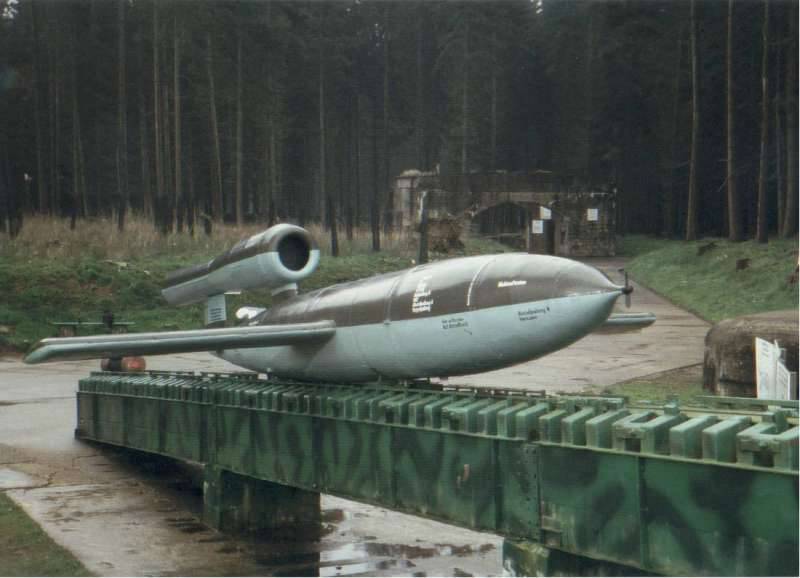
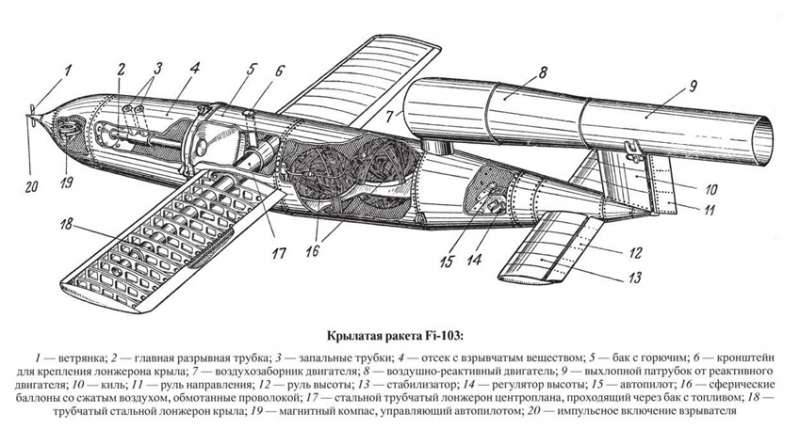
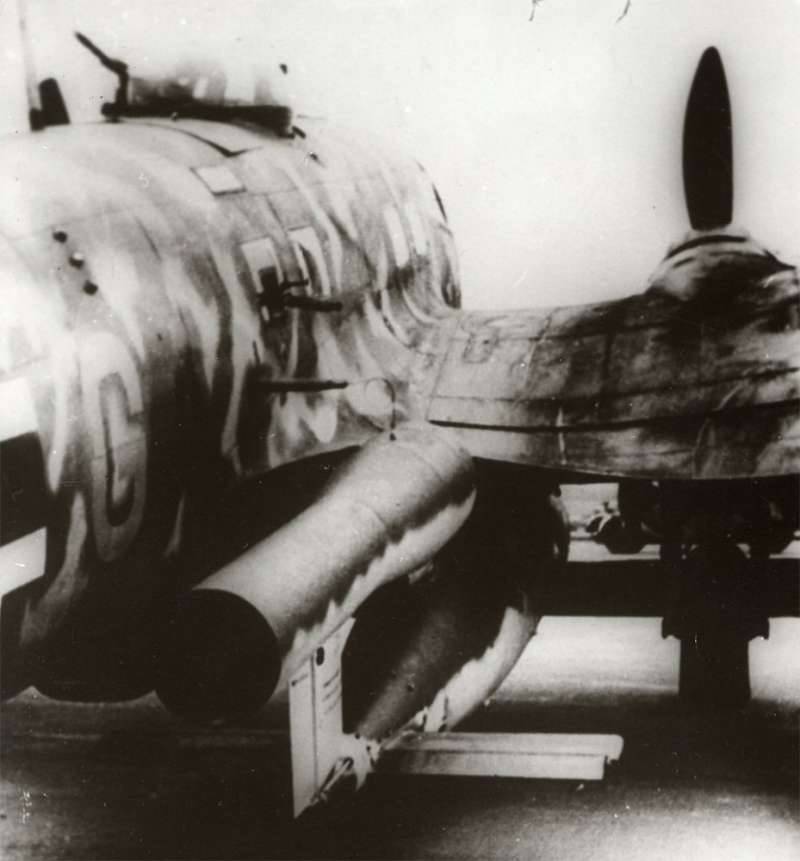

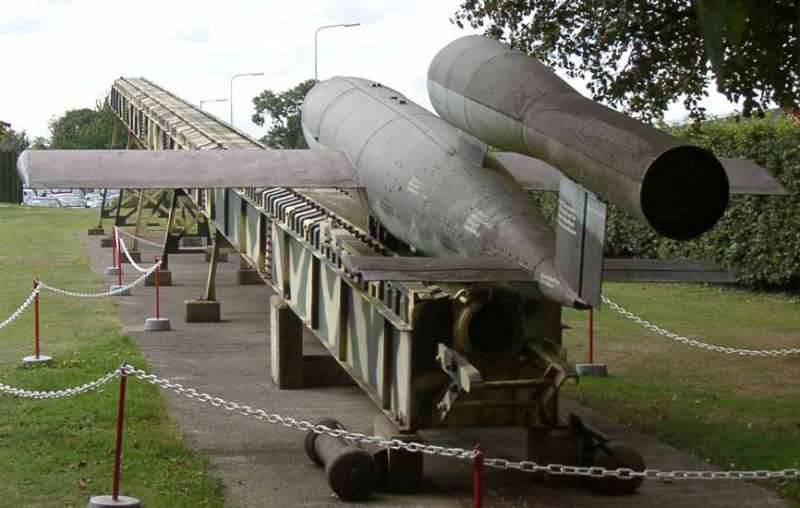
Information